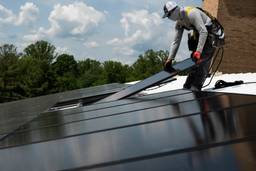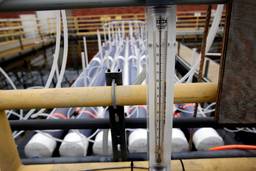Teachers’ Strikes Are Rattling Washington. This Hearing in the U.S. House Is Proof.
Rachel M. Cohen

As Denver public school teachers head back to school, ending their first labor stoppage in 25 years, it’s hard to dismiss the impact the nation-wide teacher strikes have had on American politics. As Democratic presidential candidates rush to voice support for the Colorado educators, Denver’s strike marks the ninth major teacher uprising in the last twelve months, with the anniversary of the very first — West Virginia’s — coming up next week.
Survey after survey has shown the striking teachers have gotten their message across: The majority of Americans agree teacher pay is a real problem. The annual PDK poll reported in September that two-thirds of people say teacher salaries are too low — a new high in its data since the poll started in 1969. Another national poll released in April found 78 percent of adults think schools don’t pay teachers enough, and 52 percent supported those going on strike over wages.
As further evidence of how the teacher protests have shaped the national conversation, the House education committee convened this week for its first hearing on K-12 schools in the new Congress, and the topic of teacher pay was front and center. Republicans and Democrats both agreed that teacher salaries were simply too low.
The House Education and Labor Committee hearing, chaired by Democratic Representative Bobby Scott of Virginia, lasted three and a half hours, and was entitled, “Underpaid Teachers and Crumbling Schools: How Underfunding Public Education Shortchanges America’s Students.” Topics explored throughout the convening included more than just teacher compensation and school infrastructure. Legislators and witnesses also discussed adequate funding for students with disabilities, turnaround strategies for low-performing schools, and civil rights protections for students who attend private schools.
While lawmakers from both parties agreed public-school teachers are not earning enough money, the two parties had vastly different explanations as to why.
Witness Benjamin Scafidi, an economist and fellow with EdChoice, a national school choice advocacy group, said that while inflation-adjusted spending on public schools increased 37 percent between 1992 and 2016, real teacher salaries declined by one percent in that same period, according to data from the National Center for Education Statistics. Scafidi said this was due to the “tremendous increase” in non-teacher staff working in public schools — referring to a 52 percent jump.
Republicans seemed content to embrace the idea that the teacher salary problem was not due to their failure to fund schools properly, but because of school districts’ wasteful hiring decisions.
“It scares me when I hear people in education coming up and asking this completely broken federal government for more money when [states] are running surpluses,” said Republican Representative Glenn Grothman of Wisconsin. “Why do people think the federal government should give more money?”
Yet, according to the liberal Center on Budget and Policy Priorities, in 2015, 29 states provided less total school funding per-pupil than they had spent before the recession.
Democrats and some witnesses pushed back on the idea that schools are chock-full of superfluous staff, noting many workers included in this category are bus drivers, cafeteria staff, paraprofessionals, nurses, custodians and special-education aides.
Randi Weingarten, the president of the American Federation of Teachers, testified that the increase in school staff spending also overlapped with the Americans with Disabilities Act, which was signed into law in 1990. That law, and the Individuals with Disabilities Education Act, passed in 1975, obligate schools to provide students with disabilities with additional support services. Democratic Representative Joseph Morelle also noted the growing movement to provide wraparound social services in schools, since that is where students spend the bulk of their days and where it can be easier for parents to access. That sort of increased investment in community schools, he suggested, is not wasteful spending.
Some of the hearing was dedicated to discussing the Rebuild America’s Schools Act, legislation recently reintroduced by Representative Scott and Democratic Senator Jack Reed. The bill would invest $100 billion in K-12 public school infrastructure, and create an estimated 1.9 million jobs for local workers. Representative Pramila Jayapal, a Democrat from Washington and the co-chair of the Congressional Progressive Caucus, spoke of schools where students and teachers are forced to hold their feet over hot plates to keep warm. Even Representative Ron Wright, a Republican from Texas who voiced skepticism for new spending on education, admitted he never had an air conditioner in his overly warm Texas public schools until he reached high school; he said he’d be open to support air conditioners at least for Texas schools.
One 2016 report on national school infrastructure needs estimated it would cost roughly $145 billion annually to maintain and modernize school buildings to the point where all were in safe condition. While federal spending accounts for about 10 percent of school operating budgets, the feds currently spend virtually nothing on school infrastructure. The bulk of those facility costs fall on local governments, which results in a system where wealthier communities can afford to have nicer school buildings, and can more easily make necessary building repairs.
At the hearing, Chairman Scott noted his school infrastructure legislation would create more jobs than the Republican tax bill did, and at 5 percent of the cost. The last time Congress came close to authorizing federal school infrastructure spending was in 2009 as part of the stimulus bill. But Senator Susan Collins, a Maine Republican, said she wouldn’t support Scott’s legislation, arguing that school facilities should remain exclusively a local responsibility. As a result, communities across the country lost out on billions of dollars to fix their crumbling schools.
The Republican tax bill made two other appearances during Tuesday’s hearing. Residents who live in areas with higher state and local tax burdens had previously been able to deduct those costs on their federal taxes, so as to avoid paying twice. But in the legislation President Trump signed in 2017, individuals can now only deduct up to $10,000 in state and local taxes, and freshman Democratic Representative Lauren Underwood noted at the hearing that residents in her home state of Illinois have been very anxious about their skyrocketing tax bills. “We want our money to go to schools, not tax cuts for corporations,” she said. Other states feeling the brunt of the new SALT cap are California, New York, Connecticut, and New Jersey.
The second time the GOP tax bill came up was in reference to so-called “Opportunity Zones,” which are federal subsidies directed toward investment in distressed areas to supposedly revitalize the areas. Ranking committee member Virginia Foxx, a Republican from North Carolina, said while she’d like to see teachers take home more money, she’s not interested in increasing federal investment in school budgets. Noting the expansion Opportunity Zone funding in the new tax bill, Foxx suggested that community development could perhaps somehow lead somehow to increased teacher pay.
“Time will tell if Opportunity Zones and other new initiatives will finally help us solve the problems of teacher pay and poor school facilities, but time has already told us that higher price tags and more bureaucracy in Washington won’t deliver results,” she said. “The answer is not more money.”
As federal lawmakers continue to bicker over how we got to this point, teachers aren’t waiting around. Earlier this month, 95 percent of Oakland teachers voted to authorize their own strike, and they too could walk out of their schools within days.







